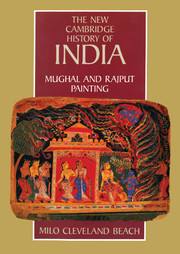Book contents
- Frontmatter
- Introduction
- 1 Painting in North India before 1540
- 2 1540–1580: Painting at Muslim courts
- 3 1580–1600: The new imperial style and its impact
- 4 1600–1660: Mughal painting and the rise of local workshops
- 5 1660–1700: The growth of local styles
- 6 1700–1800: The Dominance of Rajput Painting
- 7 1800–1858: Traditionalism and new influences
- Appendix
- Bibliographical essay
- Index
- The New Cambridge History of India
Bibliographical essay
Published online by Cambridge University Press: 28 March 2008
- Frontmatter
- Introduction
- 1 Painting in North India before 1540
- 2 1540–1580: Painting at Muslim courts
- 3 1580–1600: The new imperial style and its impact
- 4 1600–1660: Mughal painting and the rise of local workshops
- 5 1660–1700: The growth of local styles
- 6 1700–1800: The Dominance of Rajput Painting
- 7 1800–1858: Traditionalism and new influences
- Appendix
- Bibliographical essay
- Index
- The New Cambridge History of India
Summary
PAINTING BEFORE I540
Few recent studies of Indian painting have considered the established traditional Indian styles out of which Sultanate, Rajput, Mughal, and Deccani painting developed and in the context of which they should more frequently be seen. Douglas Barrett and Basil Gray, Indian Painting, Geneva, 1963, did discuss the earlier traditions of wall-painting, and their discussion provides a framework for very necessary future studies; otherwise, however, their survey study - although the best currently available - has long been out of date. Ajanta Murals, edited by A. Ghosh, New Delhi, 1967; C. Sivaramamurti, South Indian Paintings, New Delhi, 1968; Amancharla Gopala Rao, Lepakshi, Hyderabad, 1969; and C. Sivaramamurti, Vijayanagara Paintings, New Delhi, 1985, all provide important information about and reproductions of earlier wall-paintings at major sites.
Several studies provide an overview of the various regional styles of manuscript painting that immediately preceded the advent of Mughal influence. The most thorough survey, and the best introduction to the subject, remains Karl Khandalavala and Moti Chandra, New Documents of Indian Painting-A Reappraisal, New Delhi, 1969. Many of the ideas presented there are further expanded in Moti Chandra, Studies in Early Indian Painting, London, 1974. Pramod Chandra, The Tuti-Nama of The Cleveland Museum of Art and the Origins of Mughal Painting, Graz, 1976, thoroughly discusses how these pre-Mughal styles affected and directed early Mughal manuscript illustrations. It is essential reading.
- Type
- Chapter
- Information
- Mughal and Rajput Painting , pp. 240 - 247Publisher: Cambridge University PressPrint publication year: 1992



